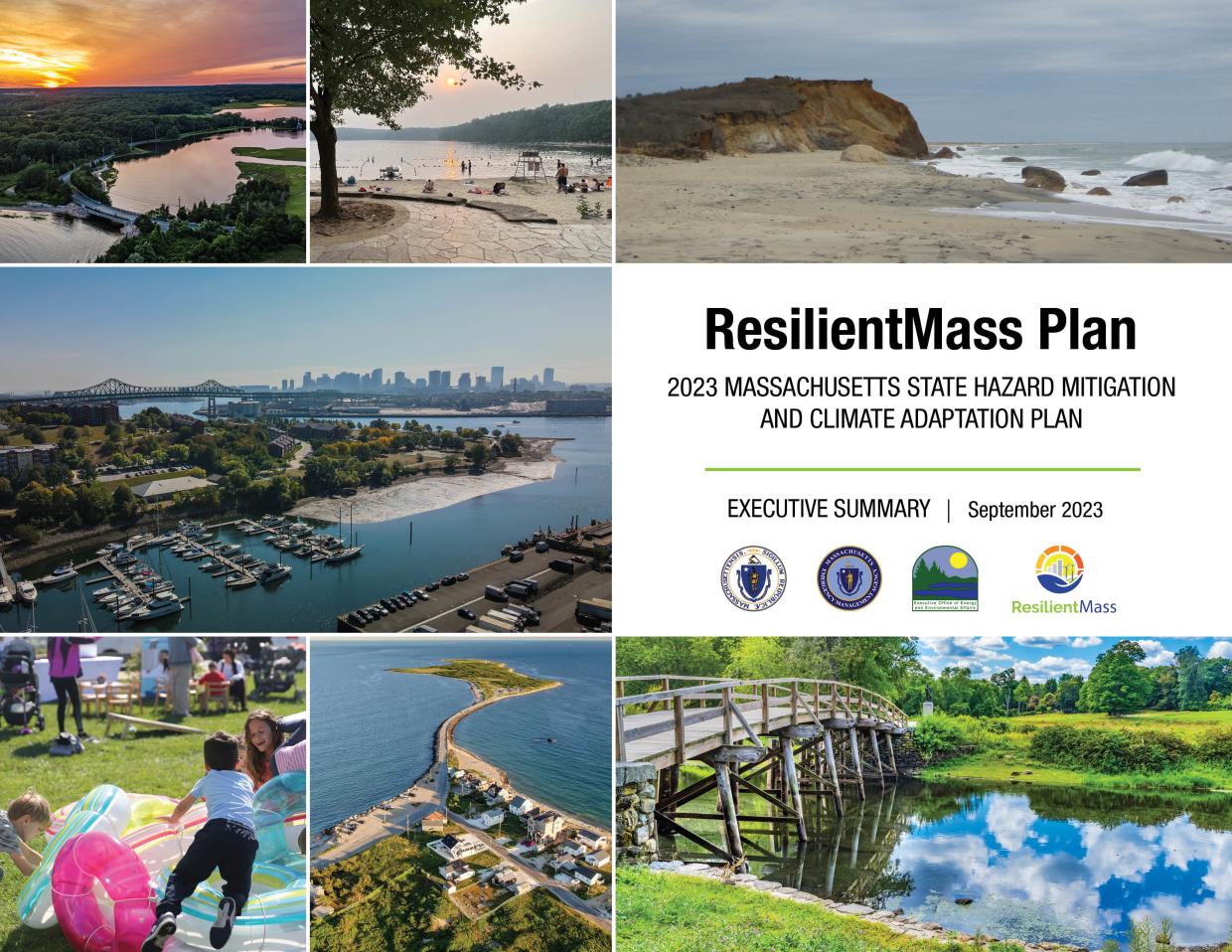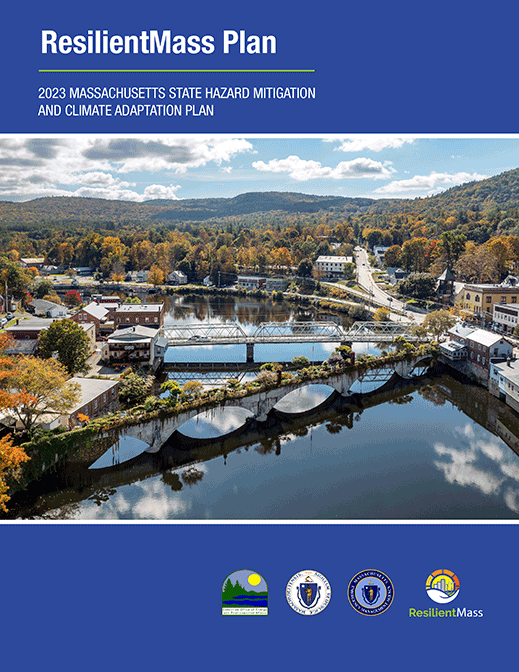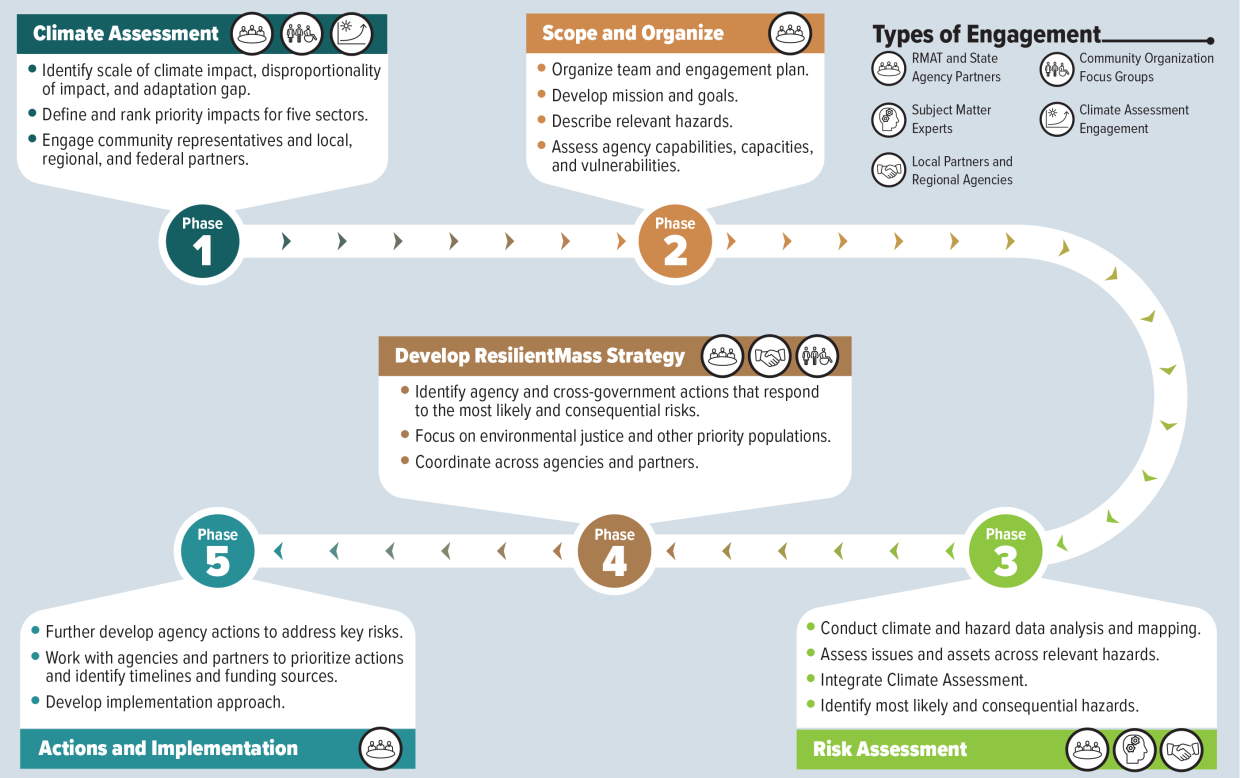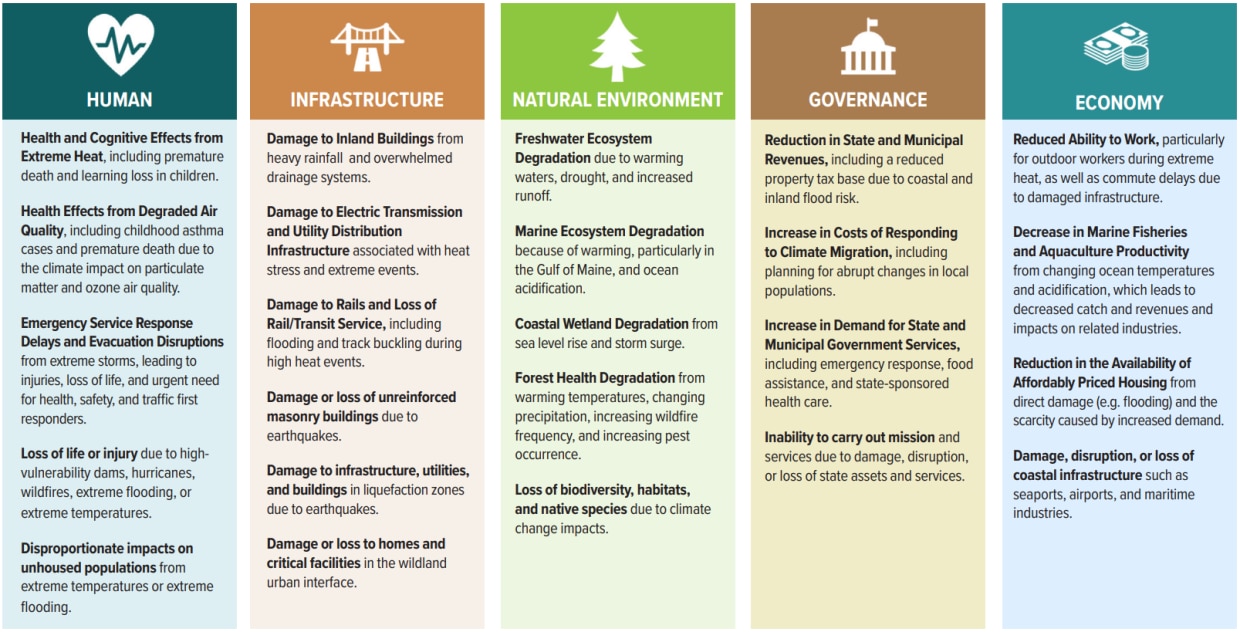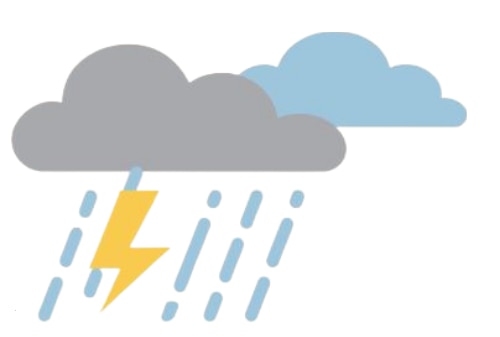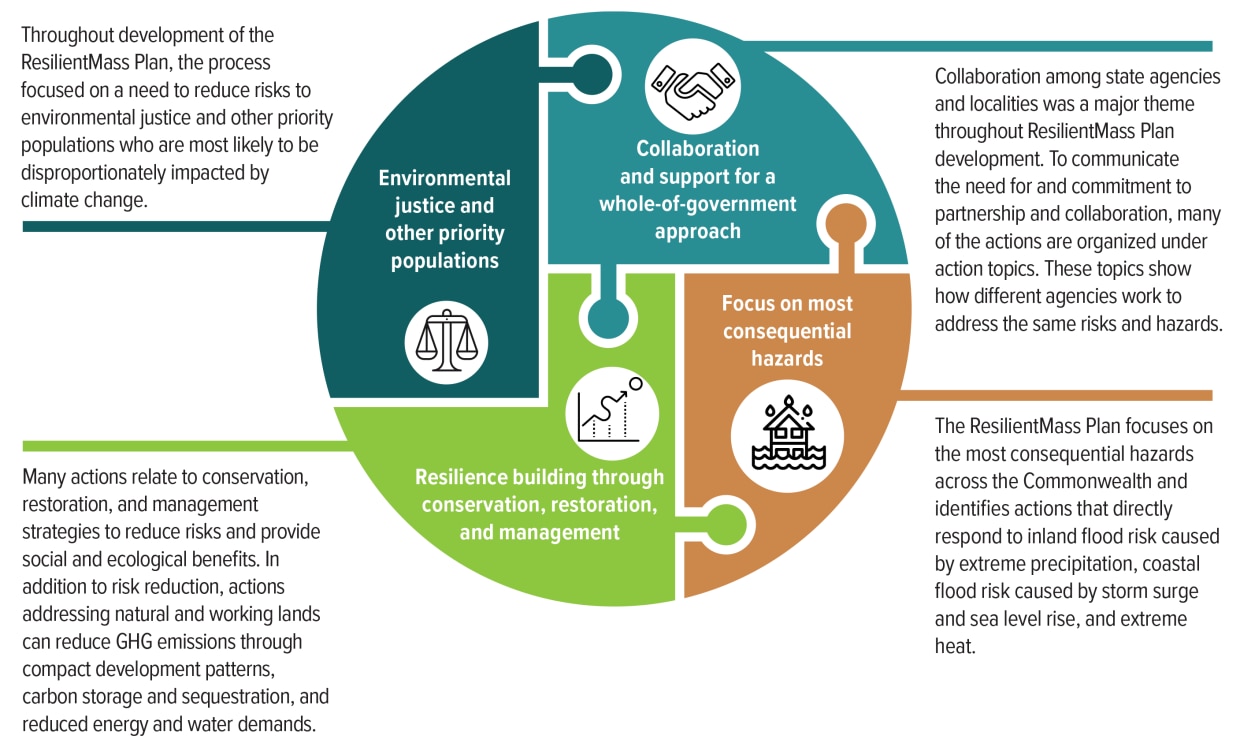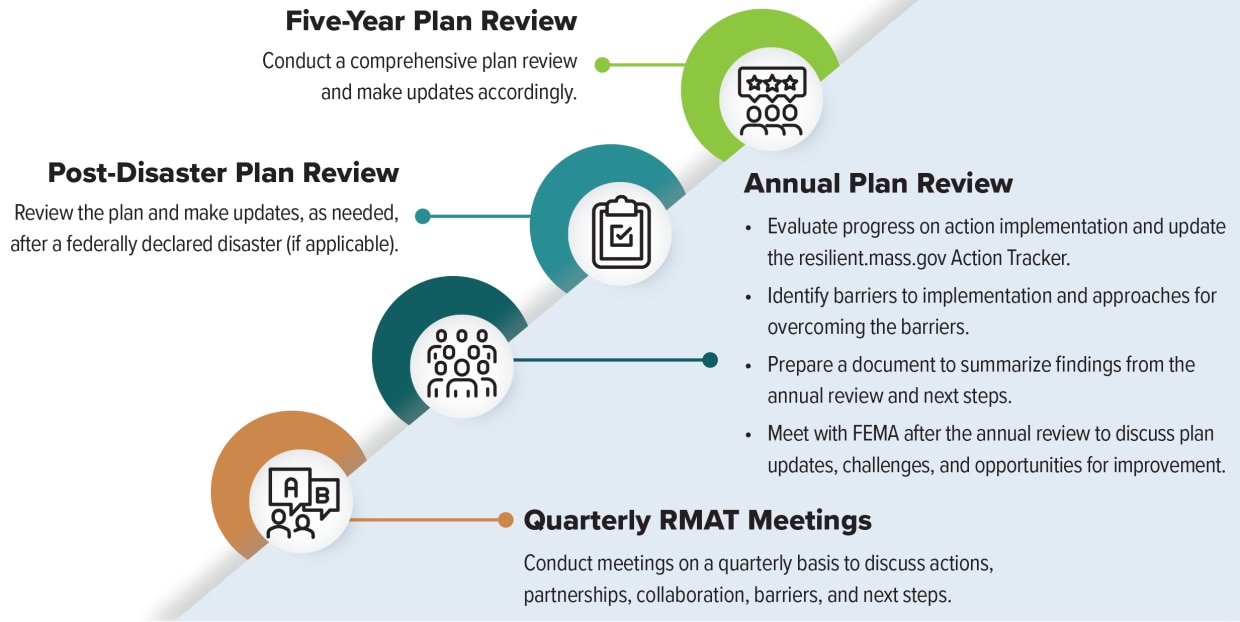Read the Executive Summary
Read the Full ResilientMass Plan
Read the full ResilientMass Plan
- Chapter 1: Introduction
- Chapter 2: Planning Process
- Chapter 3: Profile of Massachusetts' Setting and Climate Projections
- Chapter 4: State Capability and Adaptive Capacity Analysis
- Chapter 5: Risk Assessment and Hazard Analysis
- Chapter 6: State Agency Vulnerabilities
- Chapter 7: State Strategy, Actions, and Implementation Plan
- Appendices
ResilientMass Agency Action Tracker
The ResilientMass Action Tracker contains a sortable list of over 125 state agency-led actions that agencies identified through the 2023 ResilientMass planning process as priorities for increasing resilience and reducing the Commonwealth's risks and vulnerabilities related to natural hazards and projected climate changes. Each action addresses at least one of the primary statewide climate change impacts identified in the 2022 Massachusetts Climate Change Assessment, and includes information such as the lead implementing agency(ies), hazards addressed, and timeframe. This tracker is maintained by the ResilientMass Action Team (RMAT) and will be updated periodically to reflect progress in implementing these actions.
Plan Overview & Goals
The ResilientMass Plan is an innovative State Hazard Mitigation and Climate Adaptation Plan (SHMCAP) that was developed in a highly collaborative manner to fully integrate a hazard mitigation plan and a climate change adaptation plan.
The ResilientMass Plan identifies strategies and specific, measurable actions state agencies can take—individually or through inter-agency partnerships—to address risks to the human health and safety, communities, critical assets and infrastructure, natural resources, governance, and economy of the Commonwealth. The ResilientMass Plan:
- Constitutes the federally mandated 5-year update to the 2018 Massachusetts State Hazard Mitigation and Climate Adaptation Plan (SHMCAP) to maintain federal pre- and post-disaster funding eligibility.
- Identifies collaborative strategies and specific actions to increase resilience to climate change across the Commonwealth in accordance with Executive Order 569 - Establishing an Integrated Climate Change Strategy for the Commonwealth.
- Prioritizes projects that reduce risks from the priority impacts and high-consequence vulnerabilities across Massachusetts.
The ResilientMass Plan's goals include:
- Increasing collaboration across all levels of government on inclusive policies for addressing hazards,
- Employing science-based decision-making to improve effectiveness of resilience and hazard mitigation strategies,
- Increasing resilience of state assets and services,
- Implementing adaptation actions for communities and ecosystems,
- Ensuring actions to reduce hazards and climate risks consider climate mitigation and prioritize nature-based solutions.
These goals were developed through a collaborative process involving the inter-agency ResilientMass Action Team (RMAT) and local, regional, and community partners. Refer to Chapter 7: State Strategy, Actions, and Implementation Plan and the ResilientMass Action Tracker for full descriptions of the goals.
Planning and Engagement
Over the course of 18 months, the ResilientMass Action Team (RMAT) met as a working group and held meetings across Massachusetts to engage local, regional, and community partners to identify priority climate impacts across the state.
Priority Climate Impacts
The ResilientMass Plan integrates and builds on the impacts identified in the 2022 MA Climate Assessment, furthers the analysis through additional assessments of risk, and uses the findings from both processes to identify the most likely and consequential risks to the Commonwealth. See Chapter 1.2: Overview of 2023 SHMCAP, for more details on how this plan was informed by the 2022 MA Climate Assessment; see Chapter 7: State Strategy, Actions, and Implementation Plan, for the identified climate impacts and actions to address each impact. The following 24 climate impacts were identified through this process as the most urgent climate impacts.
Most Urgent Priority Impacts
Climate Risks and Vulnerabilities Across the Commonwealth
The ResilientMass Plan integrates the latest climate data and information for 15 hazards impacting the Commonwealth now and in the future. Many of these natural hazards will intensify due to climate change, particularly rising temperatures, sea level rise, changes in precipitation, and extreme weather. See Chapter 5: Risk Assessment and Hazard Analysis and Appendix 5 for more details.
Climate Projections and Impacts
Rising Temperatures
|
|
Changes in Precipitation
|
|
Coastal Flooding
|
|
Severe Weather
|
Key Findings: Risk Assessment
The greatest risks faced by the Commonwealth are posed by the following hazards, which are assessed along with other potential hazards in Chapter 5: Risk Assessment and Hazard Analysis:
- Coastal Erosion (see Appendix 5.4)
- Coastal Flooding and Sea Level Rise (see Appendix 5.5)
- Extreme Storms (see Appendix 5.12)
- Flooding from Precipitation (see Appendix 5.8)
- High Heat (see Appendix 5.2)
- Changes in Groundwater (see Appendix 5.3)
- Invasive Species (see Appendix 5.10)
- Wildfire (see Appendix 5.16)
Hazard Mitigation & Climate Adaptation Strategy
Based on the findings of the risk assessment and a collaborative action development process, the ResilientMass Plan presents two types of actions: cross-government actions, implemented across various state agencies and partners and reduce risk across the Commonwealth, and state agency actions, actions to be implemented by state agencies to reduce risk within their respective areas of responsibility. Together, the actions present a strategy for reducing risk and increasing climate resilience throughout the Commonwealth.
The 15 cross-government actions and 127 state agency actions presented in the 2023 ResilientMass Plan address critical issues such as affordable housing, coastal resources, the reliability of state assets, climate migration preparedness, food security, mental health impacts of climate change, assistance to local and regional partners, and education and outreach to communities and people of all ages. Many actions address multiple hazards. The following selection of cross-government and state agency actions highlights how actions are aligned with mitigating key hazards, and how others address some of the state’s key levers for action. Each action includes the lead agency, main partner agencies, and a timeframe for action completion. Refer to Chapter 7: State Strategy, Actions, and Implementation Plan and the ResilientMass Action Tracker for the full list of actions.
Addressing Major Climate Challenges: Examples of Cross-Government and State Agency Actions
Coastal flooding and coastal erosion
-
Develop a coastal resilience strategy for climate-resilient development and standards, coastal adaptation, and exploration of managed retreat. (Leads: EEA and CZM, Partners: HLC, DOT, DMT, DER; Timeframe: 5+ years)
-
Launch acquisition/buyout program study to explore buyouts as an option for homeowners to leave high-risk areas, with a focus on EJ and other priority populations. (Lead: MEMA; Partners: DCR, local communities; Timeframe: Less than 3 years)
Flooding from precipitation
-
Enhance consideration of resilience in the building code with key partners; integrating above-code flood standards into the statewide building code could enable municipalities to voluntarily adopt more resilient standards for construction in their communities. (Leads: EEA and EOED; Partners: DCR, OPSI, DOER; Timeframe: 5+ years)
-
Farm Climate Resiliency Program expansion will support farmers and the state agricultural system with grants including free “climate audits” for risk reduction, as well as support for climate-smart measures. (Lead: MDAR; Timeframe: Less than 3 years)
-
Protect 30 percent of land and ocean by 2030 (to align with the global 30x30 goal), implementing EEA’s Resilient Lands Initiative, incorporating the Healthy Soils Action Plan, and taking a statewide approach to increase resilience and provide carbon sinks for GHG mitigation. (Lead: EEA and DCR, Partners: DMR, DER, DMF, DFG, MDAR; Timeframe: 5+ years)
Extreme storms
-
MBTA design standards update with new standards that include climate resilience considerations for all MBTA new construction and retrofits. (Lead: MBTA; Timeframe: Less than 3 years)
-
Statewide emergency management training needs assessment to ensure emergency preparedness of state public safety officials to natural hazards, especially climate change-exacerbated hazards. (Lead: MEMA; Timeframe: Less than 3 years)
High heat
-
Develop and implement a new Heat Flag system in alignment with NOAA's Heat Advisory Criteria for New England, to identify days of extreme heat and alert people to risks, particularly children and the elderly. Lead: HHS; Partners: LWD, DPH, MEMA; Timeframe: 5+ years)
-
Identify and assess opportunities to promote cooling in residential buildings and mitigate extreme-heat risks to renters and remote workers. (Lead: EOED; Partners: HHS, HLC, LWD; Timeframe: Less than 3 years)
-
Expand DCR’s Greening the Gateway Cities program into additional EJ communities and increase tree-planting efforts across low-canopy-cover EJ neighborhoods to mitigate heat island effects, combat adverse effects of climate change, reduce energy costs, absorb and filter pollutants, and decrease water runoff. (Lead: DCR; Partners: Municipalities; Timeframe: 3-5 years)
Leveraging the Government Toolbox: Examples of State Agency and Cross-Government Actions
Provide funding and technical assistance
-
Increase funding to support municipal and agency resilience actions and funding by identifying new and sustainable revenue streams and developing a funding portal for state grant programs. (Leads: EEA, A&F; Partner: DPH; Timeframe: 5+ years)
-
Develop a strategy to identify resilience funding needs and leverage federal funding to support adaptation projects, standardizing approaches to identifying resilience needs for state capital planning. (Leads: A&F; Partners: DCAMM, MEMA, EEA, OCIR, Governor’s Office Director of Federal Funds and Infrastructure, DOT, EOED; Timeframe: Less than 3 years)
-
Provide municipal and local health climate equity training and technical support with a Massachusetts-specific training module for local health officials to increase awareness about the disproportionate health impacts of exposure to climate change hazards, and meaningfully engaging vulnerable communities. (Lead: DPH; Partners: DOC, MDAR; Timeframe: 3-5 years)
Plan, regulate, and demonstrate
-
Implement a resilience strategy at state-aided public housing and request grant funding for climate resilience projects, including five in-progress projects. (Lead: HLC; Partners: EEA, MEMA, DPH; Timeframe: less than 3 years)
-
Develop a framework for statewide resilience progress tracking, identifying statewide climate resilience goals and associated metrics to inform funding strategies. (Lead: EEA; Partners: DCR, DOT, EOED; Timeframe: 5+ years)
-
Conduct a climate migration assessment on the scale, impacts, and timing of climate migration to Massachusetts and identify opportunities, challenges, and approaches to preparing for in-migration. (Lead: EEA; Partners: OCIR, MEMA, EOED, HHS; Timeframe: Less than 3 years)
Convene, communicate, and prioritize
-
Launch an Office of Climate Science to serve as an authoritative resource on statewide climate data and models, and to partner with universities on climate science needs. (Lead: EEA; Partners: TSS, DOT, DMF; Timeframe: 5+ years)
-
Launch a statewide Climate Communications Campaign, targeting climate actions for decarbonization and resilience and access to resources to take critical action. (Lead: EEA; Timeframe: 5+ years)
-
Update school curriculum to include climate science and green workforce development, piloting clean energy innovation pathway for high school students to gain applied learning experience in the renewable energy sector. (Lead: EOE; Partners: HLC, LWD, HHS; Timeframe: 5+ years)
ResilientMass: A Living Plan
The ResilientMass Plan is a living document that will evolve as actions are implemented and new data and information are incorporated into the planning process. The ResilientMass Plan will continue to be effective through implementation and maintenance conducted by RMAT, state agencies, and partners over the next five years.
Implementation
Over the next five years, each of the state agencies identified as leads, partner agencies, and other collaborators will implement the actions presented in Chapter 7: State Strategy, Actions, and Implementation Plan. The Commonwealth will use the ResilientMass Action Tracker to monitor the implementation status of each action.
Maintenance
The RMAT and partners will perform the following activities to ensure the ResilientMass Plan is implemented and updated, as needed, to remain effective at reducing risk and increasing resilience across the Commonwealth (see Chapter 7: State Strategy, Actions, and Implementation Plan for more details):
Quick Links
- ResilientMass Homepage
- ResilientMass Site Map
- 2022 Massachusetts Climate Change Assessment
- 2023 ResilientMass Plan Action Tracker
For more information, contact rmat@mass.gov.
